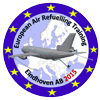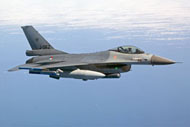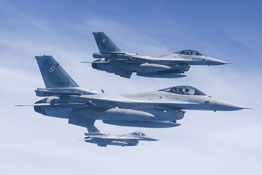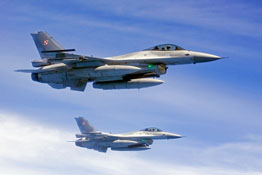The European Defence Agency (EDA), in cooperation with the European Air Transport Command (EATC), held the first European Air Refueling Training (EART) in 2014. It was held at Eindhoven Air Base and supported the exercise Frisian Flag, which simultaneously took place from Leeuwarden Air Base. Several military operations in the past, especially Unified Protector during the Libyan civil war in 2011, showed the need to increase the employability of the current European tanker fleet. An important requirement to establish this is that aircrews and ground staff are adequately trained. Between the 13th and 24th of April, 2015 to the second edition of the EART took place.
Organization
In 2004 the European Union (EU) established the EDA. The EDA's task, among others, is to improve the capabilities  of the European defense in the field of crisis management and to support the development of European defense to the future. EATC supports EDA with that, specifically with organizing the strategic airlift in Europe as effectively and efficiently as possible. Several European countries have tanker aircraft in service. These, however, are not all of the same type. To enhance the employability of the joint European tanker fleet, it is important that countries are able to work together, even though AAR procedures, aircraft and refueling methods are different. To achieve this, the EDA and the EATC jointly organized the first EART in 2014.
of the European defense in the field of crisis management and to support the development of European defense to the future. EATC supports EDA with that, specifically with organizing the strategic airlift in Europe as effectively and efficiently as possible. Several European countries have tanker aircraft in service. These, however, are not all of the same type. To enhance the employability of the joint European tanker fleet, it is important that countries are able to work together, even though AAR procedures, aircraft and refueling methods are different. To achieve this, the EDA and the EATC jointly organized the first EART in 2014.
Target EART
EARTs target is to train crews in refueling fighter aircraft in the air, during simultaneous combat missions in realistic conditions. In addition, it is intended that the European countries that employ tankers are certified to refuel as many different types of aircraft as possible, in order to increase the efficient deployment of the European tanker fleet.
The EART14 was the first exercise in which various air forces worked together from a central location to refuel a complete fleet in the air within - although staged but - very realistic training conditions. Frisian Flag appeared to be an interesting practice environment. Not to disrupt this exercise and simultaneously get the most profit possible to the EART, the AAR had to be done at the right time and placed in a well-coordinated manner. The logistics cooperation on the ground was thereby essential. Lieutenant-colonel Metodi Metodiev of the Bulgarian Air Force, working with the EDA as project manager AAR said last year hence: "After the EART14 we will evaluate the progress of the exercise. On this basis, we determine whether the EART in this form or another will be organized next year and whether there is sufficient reason to structurally organize the exercise."
Meaningful and therefor continued
The conclusion about the EART14 was very positive. Captain Eric van Osch, project officer EART, said the following: "The conclusion about EART 2014 is that both the EDA and the EATC as well as the organization of the exercise Frisian Flag are delighted with the results. Continuation of the multinational AAR exercise which simultaneously offers more AAR capacity for Frisian Flag for both exercises is a win-win situation. Therefore, we organized the training again this year, again simultaneously with Frisian Flag." To the question if there are differences between EART15 and the previous edition, Van Osch said: "There are certainly differences. In 2015, several observers will witness the exercise and will evaluate the multinational cooperation aspects. The observers are more prominently presents than last year, because the exercise enjoys increasingly international interest. The field has grown. Not only Germany, Italy and the Netherlands participate, also France does now. Other countries such as the United Arab Emirates send observers to consider their future participation." The UAE fly with an Airbus A330 MRTT, a type that next to the Boeing KC-46 could to be purchased for the future European tanker and transport unit. Van Osch continues: "The aim is that the EART in the future will be organized by different nations, several times a year, in support of or in combination with various national and international exercises. This will increase the number of possible exercises for AAR units and it offers the possibilities to simultaneously work on a standardized AAR support for European air forces and those of other NATO member states.
Planning
Another conclusion of the EDA in response to the first EART was that NATO lacked a multinational training for the AAR planning. Because it appeared to be a need, the Combined Air Operations Centre (CAOC) of NATO together with the European Headquarters Allied Air Command (AIRCOM) at Ramstein Air Base, Germany, and the Joint Air Power Competence Centre (JAPCC) located in Kalkar, Germany, developed such a training. "The first Specialized Heavy Air Tanker Course (SHARC) was held in February 2015. The students were trained in scenarios that they will experience during large-scale exercises or real operations. It allows for standardization and continuous improvement within the NATO AAR community. The graduates of SHARC then participated in the EART to put theory into practice. The practical training during EART is a logical next step in the theoretical SHARC," said Van Osch. This year the SHARC and EART were held in a logical connection and in were brought together for the first time.
Focus 2015
The EDA and the EATC organize EART together, but each organization has its own task to perform. Van Osch: "The EDA provides support at the diplomatic level and the EATC needs to provide a Host Nation and airbase. Just like last year, the training will be supported by Eindhoven Air Base in The Netherlands, but the idea is that other countries are going to fulfill that role in the near future. Together with the participating countries EATC then fills the practical training aspects. This is the responsibility of a training supervisor."
Given the objective of the EART and the previously described evaluation results, the 2015 edition focused on procedures such as joint planning (planning AAR during Frisian Flag), rendezvous procedures (procedure to be called receivers when arriving at the tanker aircraft) and emergency procedures like a crash, including the Search and Rescue thereafter.
EART15 was gradually built up. In the beginning of the training so called single-ships missions were flown. As the training advanced the participating tankers were part of the Combined Air Operations missions of Frisian Flag. Refueling fighter jets in itself is a regular job for the tanker crews. However, an exercise as Frisian Flag combined with the EART asks more of them. Although they fly in a simulated but realistic war situation, sometimes as much as 50 different fighters and three or four tanker aircraft simultaneously are active within the marked flying zone. This requires a high degree of concentration from the crews. Not only in the air, also on the ground. Just as in real war situations circumstances sometimes change very quickly in succession. That means planning also changes continuously, so even the ground staff trains under realistic conditions.
With their explanation Van Osch and other participating tanker crew members endorse exactly what the EDA and EATC aim to achieve with the multinational EART. An exercise which demonstrated the usefulness and necessity after two editions emphatically and therefore will be continued. Not only in combination with Frisian Flag, most likely also with other major exercises elsewhere in Europe.
This article was published in Polish magazine 'Lotnictwo', edition 6/2015. Click here to see the article.
We would like to thank 1st Lieutenant Dick Hoeflaken, 2nd Lieutenant Kevin Ijpelaar and Major Karen Keissen of Eindhoven Air Base public affairs office and Captain Norbert Thomas of the EATC public affair office for their help and effort which resulted in creating this article.















